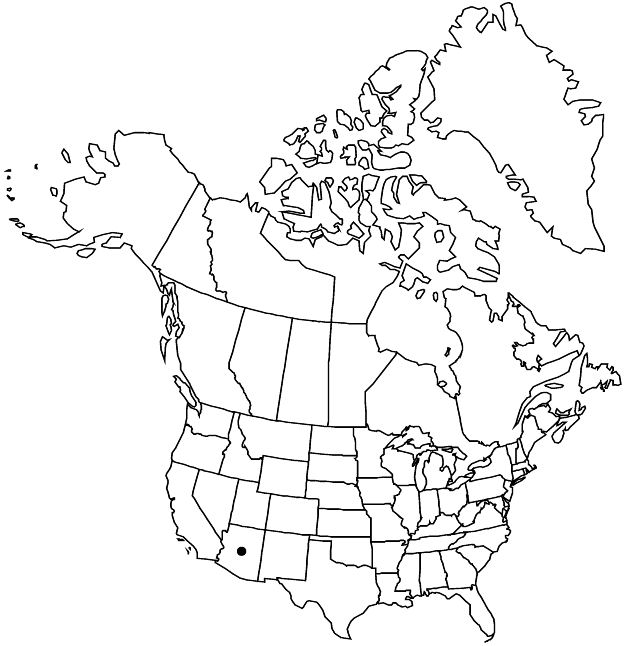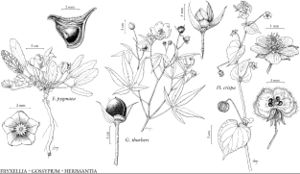Difference between revisions of "Gossypium thurberi"
Relaz. Cult. Coton., 120. 1877.
FNA>Volume Importer |
imported>Volume Importer |
||
| (6 intermediate revisions by 2 users not shown) | |||
| Line 10: | Line 10: | ||
|special_status={{Treatment/ID/Special_status | |special_status={{Treatment/ID/Special_status | ||
|code=F | |code=F | ||
| − | |label= | + | |label=Illustrated |
}} | }} | ||
| − | |basionyms={{Treatment/ID/ | + | |basionyms={{Treatment/ID/Basionym |
|name=Thurberia thespesioides | |name=Thurberia thespesioides | ||
|authority=A. Gray | |authority=A. Gray | ||
| + | |rank=species | ||
| + | |publication_title=Pl. Nov. Thurb., | ||
| + | |publication_place=308. 1854, | ||
}} | }} | ||
|synonyms= | |synonyms= | ||
| Line 31: | Line 34: | ||
|elevation=800–2400 m | |elevation=800–2400 m | ||
|distribution=Ariz.;Mexico (Chihuahua;Sonora). | |distribution=Ariz.;Mexico (Chihuahua;Sonora). | ||
| − | |discussion=<p>Gossypium thurberi occurs in central to southern Arizona, from Yavapai to Cochise counties.</p> | + | |discussion=<p><i>Gossypium thurberi</i> occurs in central to southern Arizona, from Yavapai to Cochise counties.</p> |
|tables= | |tables= | ||
|references= | |references= | ||
| Line 40: | Line 43: | ||
-->{{#Taxon: | -->{{#Taxon: | ||
name=Gossypium thurberi | name=Gossypium thurberi | ||
| − | |||
|authority=Todaro | |authority=Todaro | ||
|rank=species | |rank=species | ||
| Line 54: | Line 56: | ||
|publication title=Relaz. Cult. Coton., | |publication title=Relaz. Cult. Coton., | ||
|publication year=1877 | |publication year=1877 | ||
| − | |special status= | + | |special status=Illustrated |
| − | |source xml=https:// | + | |source xml=https://bitbucket.org/aafc-mbb/fna-data-curation/src/2e0870ddd59836b60bcf96646a41e87ea5a5943a/coarse_grained_fna_xml/V6/V6_456.xml |
|subfamily=Malvaceae subfam. Malvoideae | |subfamily=Malvaceae subfam. Malvoideae | ||
|genus=Gossypium | |genus=Gossypium | ||
Latest revision as of 22:21, 5 November 2020
Plants 2 m, freely branching. Stems 5-angular when young, glabrate. Leaves: stipules linear, 5–10 mm; petiole quadrangular, 1/2–3/4 as long as blade; blade deeply 3–5-lobed, lobes narrowly lanceolate (4+ times as long as wide), 5–15 cm, membranous, base subcordate, apex long-acuminate, surfaces glabrate. Inflorescences: flowers sympodial. Pedicels 1–3 cm, with 3 prominent nectaries; involucellar bractlets persistent, ligulate, 0.8–1.2 cm, margins entire or apically few-toothed. Flowers: calyx 3 mm, apex truncate; petals cream, with red spot at base, sometimes spot absent, 1.5–2.5 cm; staminal column 9 mm, glabrous; style slightly exceeding androecium; stigmas 3–5. Capsules 3-locular, subglobose to oblong, 1–1.5 cm, punctate, externally glabrous, internally ciliate. Seeds 3–4 mm, glabrous or glabrate. 2n = 26.
Phenology: Flowering late summer.
Habitat: Open, arid habitats, rocky hillsides, banks of seasonal streams
Elevation: 800–2400 m
Distribution

Ariz., Mexico (Chihuahua, Sonora).
Discussion
Gossypium thurberi occurs in central to southern Arizona, from Yavapai to Cochise counties.
Selected References
None.
